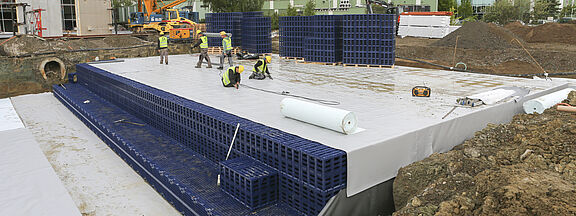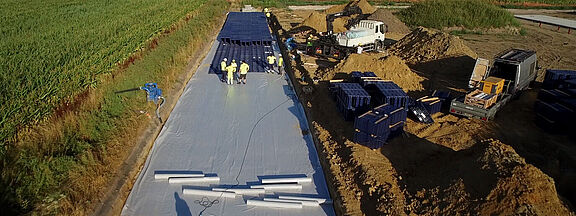SUDS (Sustainable Urban Drainage System) or Storm Tanks
The increase in urban development in modern cities has led to a decrease in the natural drainage areas for rain water. The land surface that once was grass and permeable natural ground, now is asphalt, concrete and other less permeable materials. It means that, during storm events, the water runs-off over such impervious materials and accumulates in drainage systems, increasing the volumes evacuated. When the flow rates exceed the drainage design capacity it starts flooding the adjacent areas, with the associated risk for neighbors and properties.
To alleviate that situation, Sustainable Urban Drainage Systems (SUDS) are more and more implemented in our cities. Storm tanks - also called attenuation tanks - are a type of SUDS that allow for cost-effective construction of water retention structures: the ground is excavated to the desired capacity, cellular crates made of PE are placed inside it and wrapped up with a waterproofing membrane. The storm water is collected in the void space inside the PE cells, which have a void capacity above 90% of their volume whilst keeping a certain bearing capacity, allowing for the use of the land above them.
In order to fulfil well their function, attenuation tanks must be watertight, to avoid the water migration to the adjacent ground, which could create stability problem to the neighboring buildings. The attenuation tank is backfilled after construction, so the waterproofing membrane must be able to withstand the mechanical stresses applied during construction. When in use, the water inside the tank will push the membrane towards the adjacent ground, so very high hydraulic puncture resistance is needed. Also, the wrapping material must be flexible and light, to ease the installation and allow for prefabrication, maximizing the installation efficiency and minimizing the works on site. For all those reasons RENOLIT ALKORPLAN PVC membranes are the perfect choice for waterproofing attenuation tanks.










